kokoka主催の文化紹介講座に参加してきました。とても充実した時間となりましたので、体験レポートをお届けします。
I participated in a cultural introduction course organized by kokoka. It was a very fulfilling experience, and I’m excited to share my review with you.
我参加了由kokoka主办的文化介绍讲座,度过了一段非常充实的时光。我很高兴与您分享我的体验。
今回参加したクラス

今回体験した講座
「COSMOS 筝を弾いてみよう Play the Koto」
・第2・4金曜日 15:00~17:00 ¥500
(2th・4th(Fri) 3pm-7pm ¥500)
・https://www.kcif.or.jp/web/jp/classes/cosmos/
今回参加したのは、中国人留学生ヒョウと日本人ボランティアのユリ。この記事はユリが書いておりますが、恥ずかしながら日本文化への理解が大変薄く…
お箏の体験もはじめてのチャレンジ。とても楽しみにしていました。
The participants in this event were Chinese international student “Feng” and Japanese volunteer “Yuri.” This article was written by “Yuri” (apologies for the author’s very limited understanding of Japanese culture…).
Since this was the author’s first time experiencing the guzheng, they were very excited and full of anticipation before participating.
参加这次活动的是中国留学生”冯”和日本志愿者”百合”。本文由”百合”撰写(抱歉笔者对日本文化的理解非常有限……)
由于这是笔者第一次体验筝,所以参加之前非常期待,心情很激动。
まずは受付
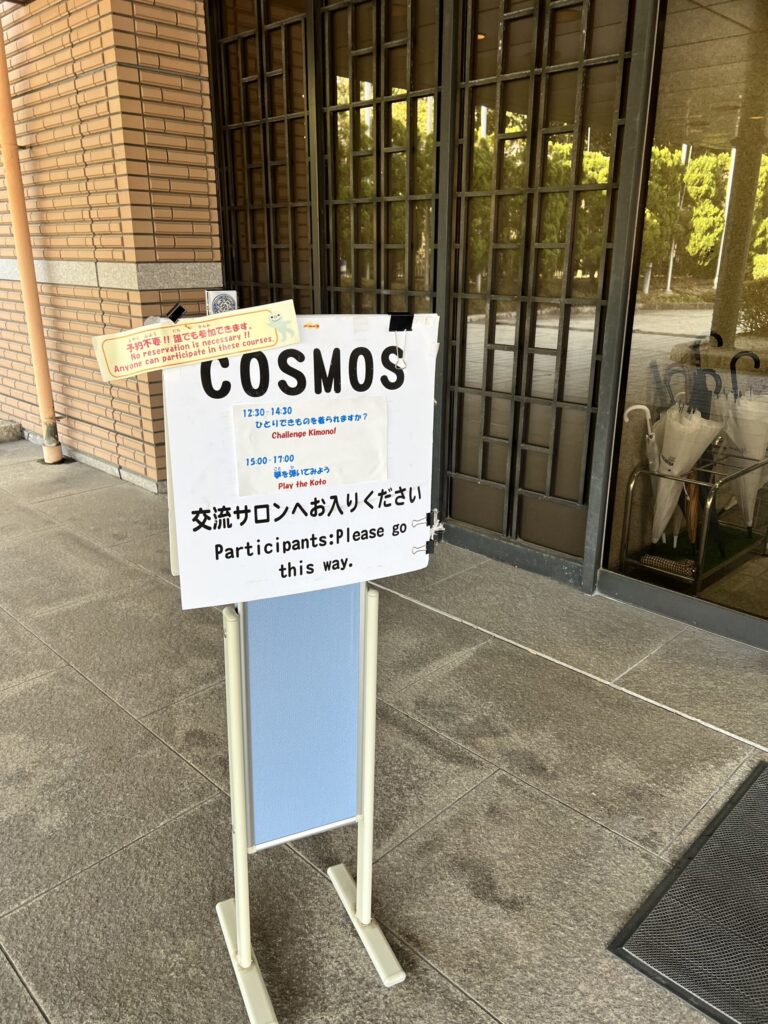
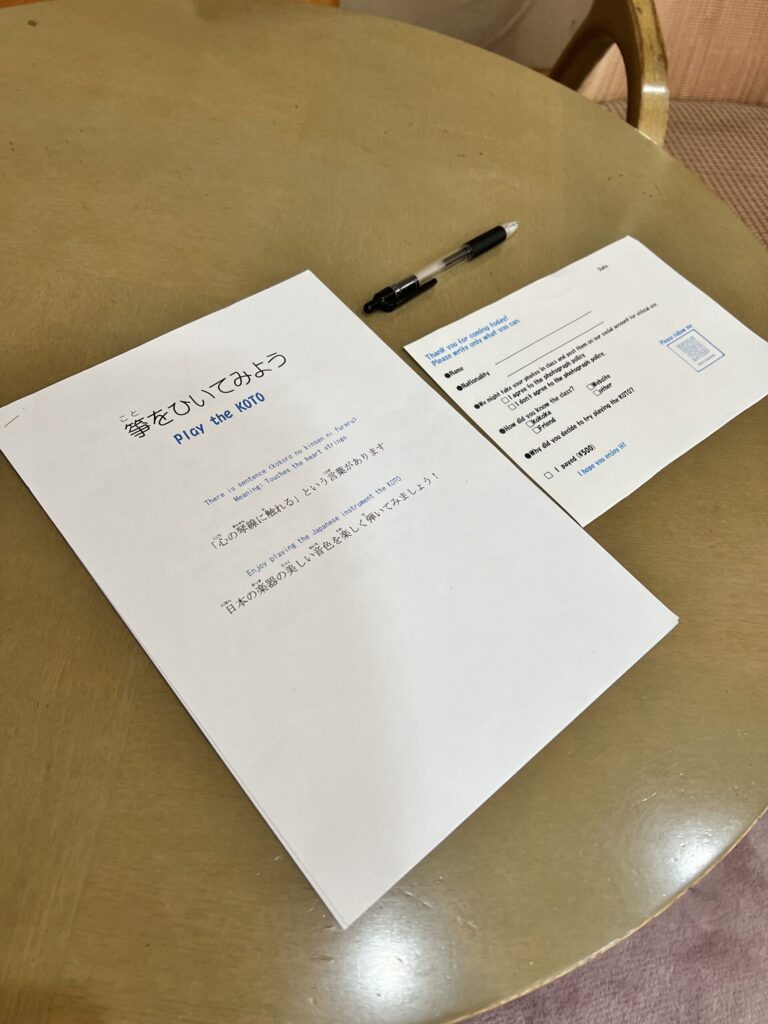
まずは会場に向かいます。
COSMOS体験クラスが開催される第2・4金曜日には、写真のように案内看板が出ています。
まずは受付を済ませて、参加費500円を支払います。
受付書類はやさしい日本語&英語で書かれているので、日本語に不安がある方も大丈夫。当日などでも空きがあれば受け入れもらえるそうなので、気軽に参加してみましょう。
First, we head to the venue.
On the 2nd and 4th Fridays when the COSMOS experience class is held, there will be a sign like the one in the photo.
First, we complete the registration and pay the participation fee of ¥500.
The registration forms are written in simple Japanese and English, so even if you’re not confident in Japanese, it’s okay. If there is availability on the day, they may accept walk-ins, so feel free to join!
首先,我们前往会场。
COSMOS体验课程将在每个月的第二和第四个星期五举办,届时会有如照片所示的指示牌。
首先完成注册并支付500日元的参加费用。注册表格以简易日语和英语书写,所以即使对日语不太自信也没问题。如果当天有空位的话,也可以接受临时参加,大家可以轻松参与!
お箏とご対面
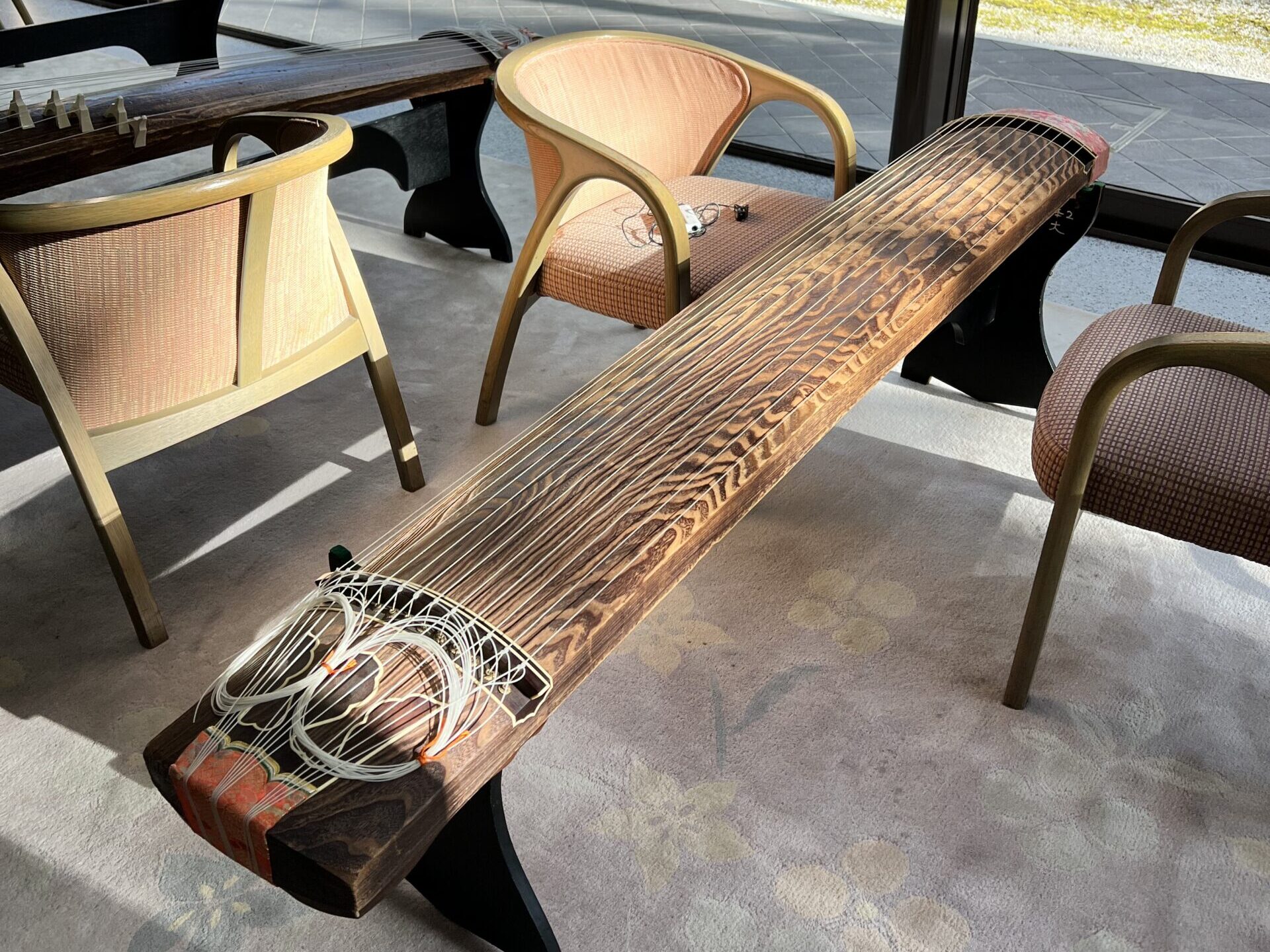
「わぁ、大きい!」なんとなく頭の中にイメージを浮かべてましたが、実際目の前にしてみると予想以上に迫力のある大きな楽器です。
それもそのはず。日本で広まっているお箏は絃が13本、そして土台の木の板の部分の長さは約180cm(6尺)だそうです。背が高めの男性がひとり横たわっているくらいのサイズ感。
全て先生がセッティングしてくださったので、持ち上げたりはしてませんが…きっとずっしりと重量のある楽器なんでしょう。はじめて触るのは、とても緊張しました。
“Wow, it’s so big!” I had an image in my mind, but when I saw it in person, it turned out to be an impressively large instrument, much bigger than I expected.
And it’s no wonder. The koto, which is popular in Japan, has 13 strings, and the length of the wooden base is about 180 cm (6 feet). It’s roughly the size of a tall man lying down.
Everything was set up by the teacher, so I didn’t lift it myself, but I’m sure it’s a heavy instrument. I was very nervous when I touched it for the first time.
“哇,真大!” 参加之前虽然脑海中有个大概的印象,但当我看到实物的时候,发现它比预想的要更大、更有气势。
也难怪。日本流行的筝有13根弦,木板的长度约为180厘米(6尺)。差不多是一个身材较高的男性躺下的大小。
所有的设置都是老师帮忙准备的,所以我没有自己搬起来,但它一定是个重型乐器。第一次接触它时,我感到非常紧张。
爪をセット


まず最初にやるべきことは「爪をつけること」でした。
可愛らしい和柄の収納ケースに入った爪。素材は象牙でつるつるテカテカしています。指がすっぽり覆われる大きさで、親指、人差し指、中指の3本指にセットするそうです。
準備はたったこれだけ!さぁ、いよいよお箏に触れていきます!
The first thing we needed to do was to put on the nails.
The nails are stored in a cute case with traditional Japanese patterns. Made of ivory, they are smooth and shiny. They are large enough to completely cover the fingers and are placed on the thumb, index finger, and middle finger.That’s all the preparation done! Now, let’s finally touch the koto!
我们首先要做的就是戴上指甲。
这些指甲装在一个可爱的和风图案的收纳盒里。它们由象牙制成,光滑且有光泽。指甲的大小足够完全覆盖手指,分别戴在大拇指、食指和中指上。准备工作就这么简单!现在,终于可以接触筝了!
基本の弾き方
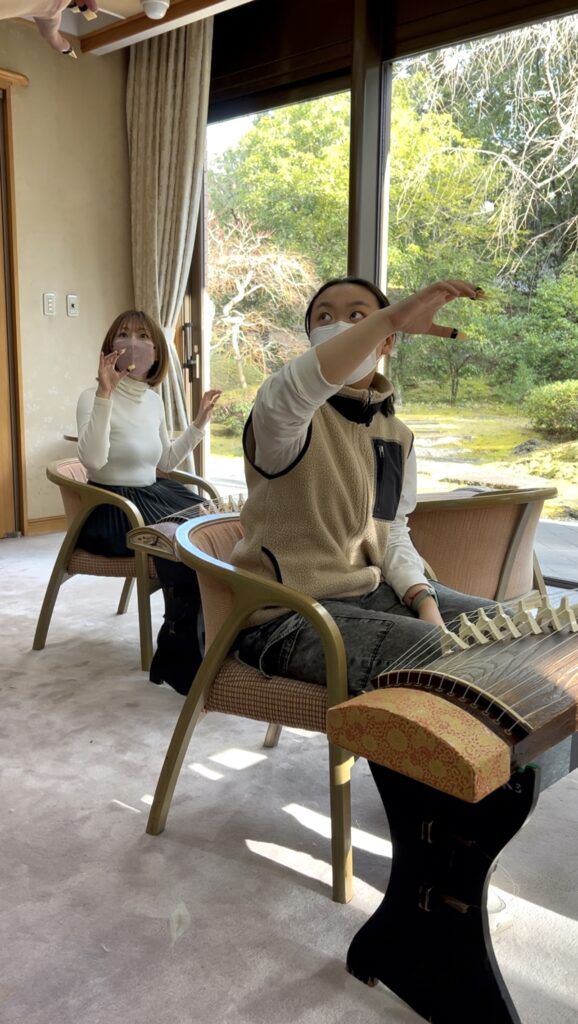
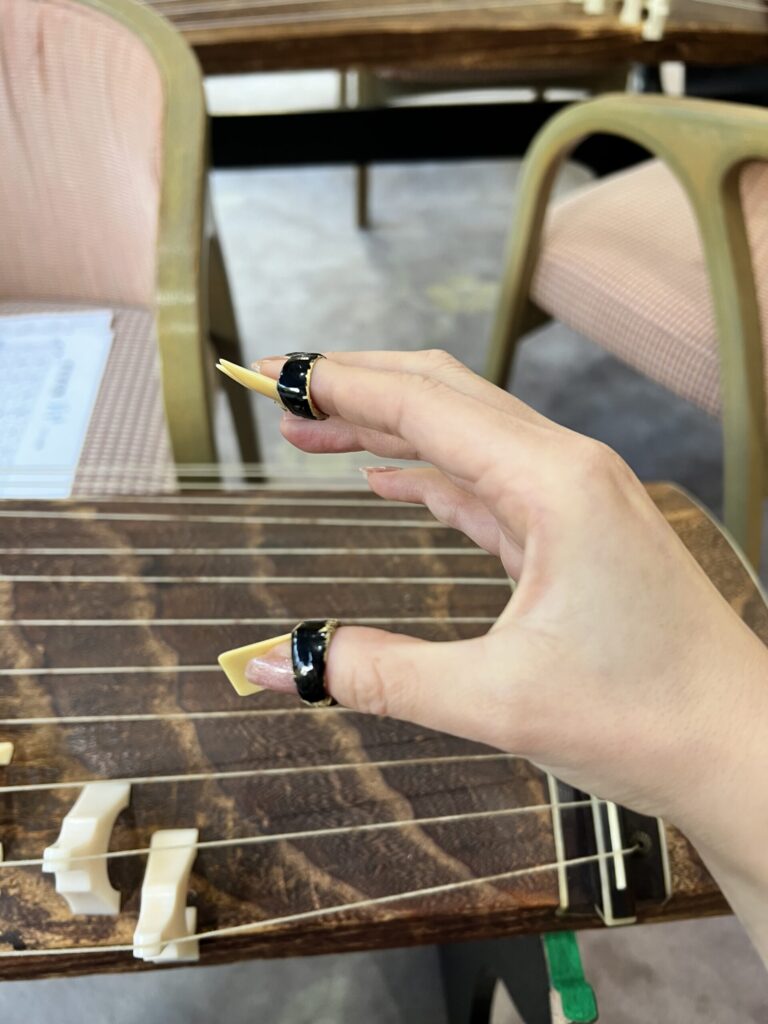
まずはお箏の前に座り、とりあえず触ってみることから始まります。
座る位置は、右端。ピアノのように真ん中あたりに陣取って演奏するものだと思ってたのですが、はじっこに座るそうです。なんとなくこれだけでも優雅な雰囲気ではないでしょうか。
そして、手の形を整えます。何かを掴む感じで丸い形にするのがコツだそう。爪をつけているせいか、たったこれだけの動作すらもぎこちない私たち…。
We sit in front of the koto and start by simply touching it.The sitting position is at the far right. I thought we would sit in the middle, like playing the piano, but it turns out we sit at the edge. Somehow, just this position gives off an elegant atmosphere.Next, we adjust our hand position. The trick is to shape your hand as if you are holding something, making a rounded form. Perhaps because we have the nails on, even this simple movement feels a bit awkward for us…
我们坐在筝前,首先从简单地触摸它开始。坐的位置是在右端。我原以为我们会像弹钢琴一样坐在中间,但实际上我们坐在了边缘。光是坐在这个位置上,就能感受到一种优雅的氛围。接下来,我们调整手的形状。诀窍是把手做成像抓住什么东西一样的圆形。可能是因为我们戴着指甲,连这个简单的动作都显得有点笨拙……
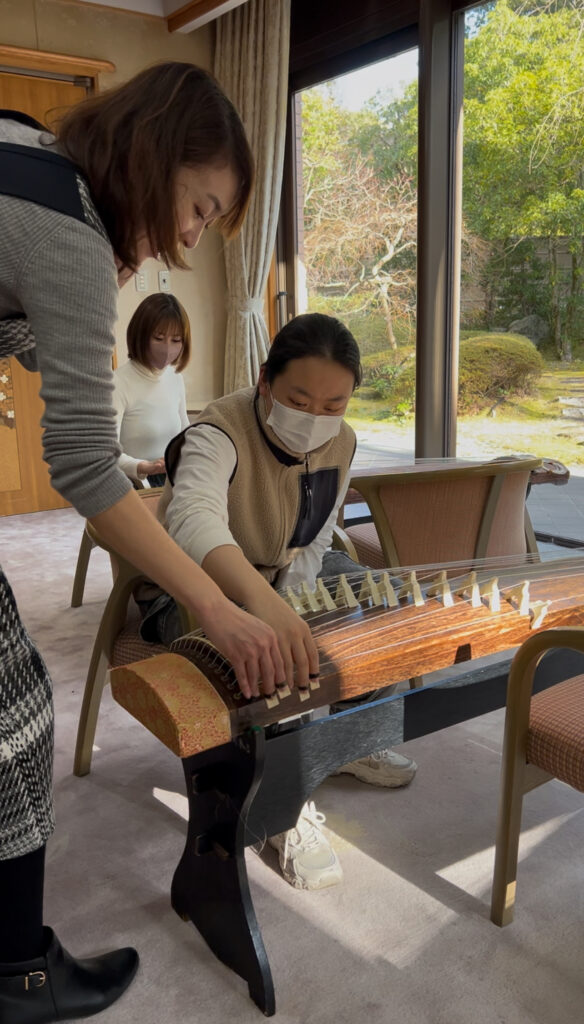

しかし、先生が丁寧にマンツーマン指導してくださいます。
優雅に軽やかにポロロローン♪と… 理想通りにはいかず。つるんと滑ったり、音が出なかったりと失敗続きですが、その度に「こうしたら?」とやさしくアドバイスをくださりました。
おかげさまで楽器経験ゼロのわたしでも、音を出せるようになりました。
However, the teacher provided careful one-on-one guidance.
Gracefully and lightly, I tried playing, but it didn’t go as expected. I kept slipping or couldn’t produce sound, but each time, the teacher gently offered advice like, “How about trying it this way?” Thanks to that, even though I had zero experience with musical instruments, I was able to produce sound.
然而,老师为我们提供了细心的一对一指导。我试着放松地优雅地尝试弹奏,但效果不尽人意,经常滑掉或者没有声音,每次老师都温柔地给出建议,“这样试试看怎么样?”尽管我没有任何乐器经验,但多亏了老师的帮助,最后终于能弹出出声音了。
楽譜を読む


全部で13絃
一二三四五六七八九十斗為巾
(いちにさんしごろくななはちくじゅうとーいーきん)
個人的に最難関だったのが「楽譜を読むこと」でした。
楽譜といえば「ドレミファソラシド~♪」をほぼ100%の方が思い浮かべると思いますが、お琴は「一二三四五六七八九十斗為巾」と日本式です。
楽譜というよりは、小学生のノートのような印象。13本の絃に対して13文字の数字なのでシンプルではありますが、実際に”楽譜をなぞりながら演奏もする”となると大混乱でした。
とは言いつつ、いつまでも楽譜と睨めっこしているわけにもいきません。ちょっと読めるようになったら、さくっと次のステップへ進みます。
Personally, the most difficult part for me was reading the music notation.
When it comes to sheet music, most people probably think of “Do Re Mi Fa So La Ti Do~♪,” but for the koto, the notation is in the Japanese style: “一二三四五六七八九十斗為巾” (1, 2, 3, 4, 5, 6, 7, 8, 9, 10, and so on).
It’s more like a simple school notebook than a traditional sheet music. There are 13 characters for the 13 strings, which makes it simple, but when I had to actually “follow the music while playing,” it was a complete mess.
That said, I couldn’t just keep staring at the sheet music forever. Once I could read a little, I moved on quickly to the next step.
个人来说,最难的部分是“读乐谱”。
提到乐谱,大多数人可能会想到“哆来咪发索拉西多~♪”,但箏的乐谱是日本式的:“一二三四五六七八九十斗為巾”。
这更像是小学生的笔记本,而不是传统的乐谱。13根弦对应13个数字字符,虽然很简单,但当我需要“一边跟着乐谱演奏”时,就完全乱套了。
虽然乐谱很难,但我并没有一直和乐谱较劲。稍微能读懂一点后,我就迅速进入下一个步骤了。
演奏チャレンジ ①きらきらぼし
まずは万国共通の童謡「きらきらぼし」です。音楽の得意不得意関係なく、みんなが歌えるメロディ。お箏にも最初の1曲として採用されているのですね。
「音楽に国境なし」こんな言葉をひっそりと心に浮かべつつ、もくもくと練習して10分ほど….。
なんとか、弾けるようになりました!
1曲目はまだぎこちなさは残りつつも、しっかり音が出ていますよね!
何も知らないところから、まずは1曲弾けるようになった!この感覚、たまりません。
For the first song, we played “Twinkle Twinkle Little Star,” a universal children’s song. Regardless of musical ability, it’s a melody that everyone can sing. It’s even the first song chosen for the koto.
“Music knows no boundaries,” I quietly thought to myself as I practiced diligently for about 10 minutes…
Finally, I was able to play it!
Though my first performance was still a bit awkward, I was able to produce sound clearly!
Starting from knowing nothing, I’ve now managed to play one song! That feeling is amazing.
首先,我们演奏了“Twinkle Twinkle Little Star”,这是一首世界知名的童谣,大家不管音乐水平如何,都能跟着哼唱。因此
它也被选为练习筝的第一首曲子。
“音乐无国界”,我在心中默默浮现这句话,同时埋头练习了大约10分钟……
终于,我能弹奏了!
虽然第一首曲子仍然有些生疏,但我已经能清晰地发出声音了!
从一无所知开始,终于学会了弹奏一首曲子!这种感觉,真是无法形容。
演奏チャレンジ ②さくらさくら
2曲目はこれぞ日本の民謡を代表する「さくらさくら」です。日本人なら誰でも知っているメロディですが、外国人のみなさんはどうでしょうか?もしかしたらホテルのロビーなんかで聴いたことあるかもしれません。
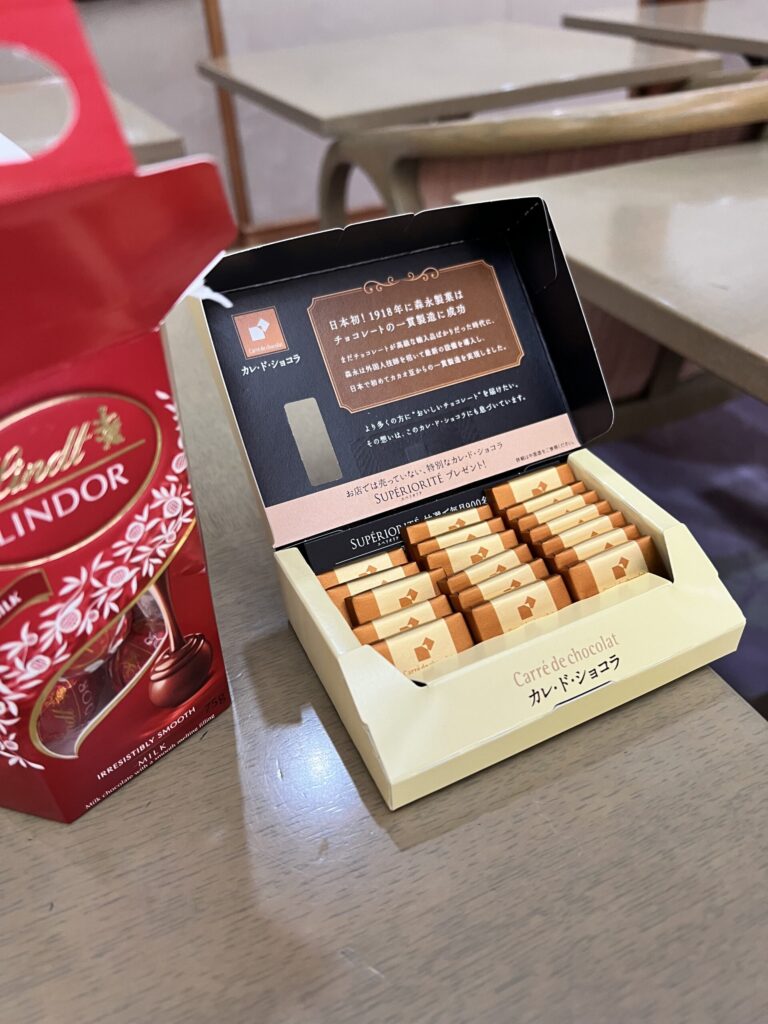

チョコで糖分補給してちょっと休憩。
こんなゆるふわな雰囲気です。
きらきら星を弾き終わって休憩している時に、何やら先生が絃を調整してくださっていたようで…一気に、和風の音階に転調!
同じ13本の絃を使うことに変わりはないのに、散りゆく花びらを思い浮かべてしまうような響きが弾き出されるようになっていました。
きらきら星と比べてほんの少し難易度が上がるこの曲も、もくもく練習。なんとかみんなで合わせられるほどに成長しました。
下記動画は参加者全員での最後の仕上げの演奏になります。ぜひ聴いていただけるとうれしいです。
The second song is “Sakura Sakura,” a representative Japanese folk song. It’s a melody that every Japanese person knows, but what about you, foreigners? You might have heard it in a hotel lobby or somewhere else.
After playing “Twinkle Twinkle Little Star,” we took a break, and while we were resting, it seemed that the teacher was adjusting the strings… and suddenly, the music shifted to a traditional Japanese scale!
Even though we were still using the same 13 strings, the sound that emerged evoked images of petals falling, bringing out a distinctly Japanese atmosphere.
This song, which is slightly more difficult than “Twinkle Twinkle Little Star,” was also practiced diligently. Eventually, we managed to play it in sync with everyone.
The following video is the final performance with all participants. I would be happy if you could listen to it.
第二首是《さくらさくら》,这首歌是代表日本民谣的经典之一。对日本人来说,这是每个人都知道的旋律,但外国朋友们怎么样呢?也许你们在酒店大厅听过它。
弹完《Twinkle Twinkle Little Star》后,我们休息了一会儿,而老师似乎在调整弦… 然后,音乐突然转向了日本风格的音阶!
虽然我们依然使用着13根弦,但奏出的声音让人不禁想起飘落的花瓣,带出了浓浓的和风氛围。
相比《Twinkle Twinkle Little Star》稍微难一些的这首歌,也在努力练习后,终于能和大家一起演奏得合拍了。
下面的视频是全体参与者的最后演奏。敬请观赏。
COSMOS申し込みはこちら
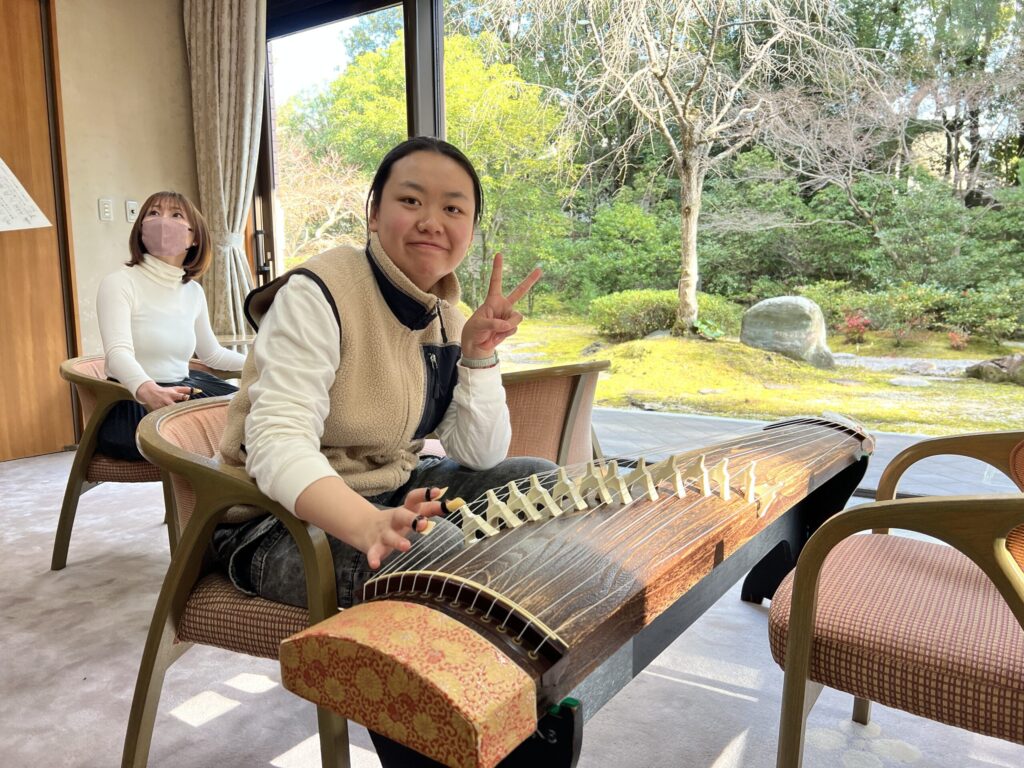
今回のお琴体験に興味を持たれた方は、ぜひ気軽に参加してみてください。インターネットにはお琴のほか、着物の着付け体験などの募集も掲載されています。みんなで楽しく、日本文化を楽しんでいきましょう。
If you’re interested in experiencing the koto, please feel free to join! In addition to koto lessons, there are also listings for kimono dressing experiences available online. Let’s all enjoy and explore Japanese culture together in a fun way.
如果您对体验筝感兴趣,请务必参加!除了筝的课程,网上还有着物穿着体验等活动信息。让我们一起愉快地享受和探索日本文化吧!
今回体験した講座「COSMOS」
・筝を弾いてみよう Play the Koto
・日時:第2・4金曜日 15:00~17:00
・料金:¥500
・WEB:https://www.kcif.or.jp/web/jp/classes/cosmos/


コメント